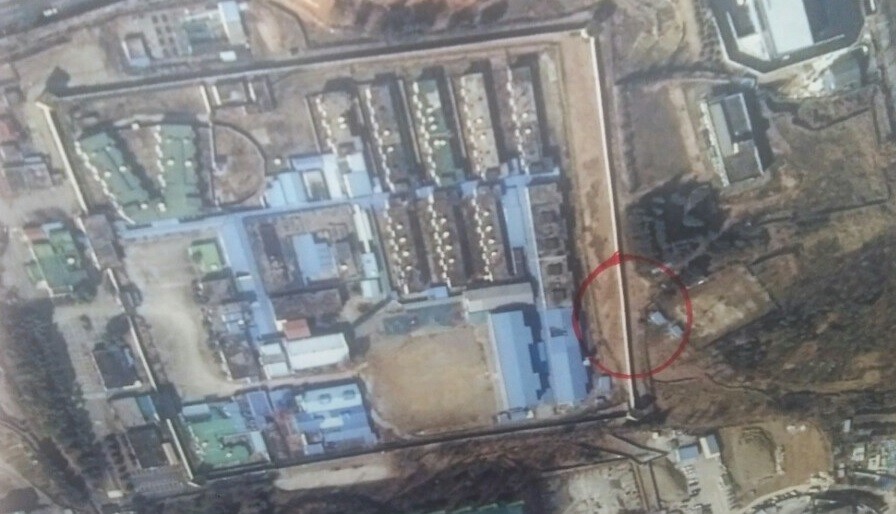hankyoreh
Links to other country sites 다른 나라 사이트 링크
Excavators begin work on presumed secret burial site in Gwangju

Excavation work has begun at the presumed site near an old prison in Gwangju where the commander of an airborne brigade said 12 citizens killed during the Gwangju Democratization Movement (which took place from May 18-27, 1980) were secretly buried.
“Excavation work will be starting as early as next week on a vacant lot near the patrol route outside the fence of the old Gwangju Prison in the Gakhwa neighborhood of Gwangju’s Buk District [relocated to the Ilgok neighborhood in 2015], which is believed to be the secret burial spot,” the May 18 Memorial Foundation said in a press briefing on Oct. 23.
The presumed site of the burial is the one marked on a map drawn by a lieutenant colonel surnamed Kim (a field battalion commander in the 3rd Airborne Brigade, which was deployed to the old Gwangju Prison on May 21, 1980) during a deposition at the Seoul Central District Prosecutors’ Office on May 29, 1995. “Twelve bodies, including the bodies of three individuals who died while they were being transported from Chonnam National University to Gwangju Prison, were buried, with the work beginning at 6 pm on May 29, 1995, and lasting for about two hours. Coffins were not used, and the bodies were covered with straw bags, with one bag for every two bodies,” Kim testified.
The presumed site of the secret burial, which is about 117 meters long and 3 to 5 meters wide, is currently covered in asphalt. It’s about 3 meters away from the path used for patrols at the prison during the events in Gwangju, located between farms that the inmates worked on and fertilized with human manure.

“When we investigated the scene on Oct. 19, a dormitory for prison guards had been built nearby, but the site was intact, aside from being covered in asphalt. We didn’t go public with the presumed site of the secret burial even after Kim’s map turned up out of concern about an attempt to cover this up,” said Jeong Su-man, a non-permanent researcher at the May 18 Memorial Foundation. This also coincides with the site that an inmate at Gwangju Prison at the time surnamed Choi identified as the presumed location of the secret burial.
The former Gwangju Prison is regarded as the likely spot where the secret burial occurred. Even though the military’s inquiry into the Gwangju riot determined that 28 civilians had died in or near the Gwangju Prison, only 11 victims (including Koh Kyu-seok) were identified in the prosecutors’ investigation, leaving 17 people unidentified. Bodies have been found for only six of the 82 missing persons recognized by the Act on Compensation for People Connected with the May 18 Democratization Movement, and not even the remains have been located for the other 76.
“There are 295 people from 130 families who relatives said went missing during the riot in Gwangju and for whom DNA samples have been collected from strands of hair,” said a spokesperson for the city of Gwangju. Around next week, the May 18 Memorial Foundation will be embarking on the excavation of the presumed site of the secret burial, utilizing the methods used for excavating cultural artifacts.
“It appears to be true that the airborne brigade buried the bodies at that time, and I think we can figure [recovering the bodies] out, too. But if we use the cultural heritage excavation method, we can also learn how they were buried and how the digging took place,” said Kim Yang-rae, a permanent member of the foundation’s board.
By Jung Dae-ha, Gwangju correspondent
Please direct questions or comments to [english@hani.co.kr]

Editorial・opinion
![[Column] Season 2 of special prosecutor probe may be coming to Korea soon [Column] Season 2 of special prosecutor probe may be coming to Korea soon](https://flexible.img.hani.co.kr/flexible/normal/500/300/imgdb/original/2024/0426/3317141030699447.jpg) [Column] Season 2 of special prosecutor probe may be coming to Korea soon
[Column] Season 2 of special prosecutor probe may be coming to Korea soon![[Column] Park Geun-hye déjà vu in Yoon Suk-yeol [Column] Park Geun-hye déjà vu in Yoon Suk-yeol](https://flexible.img.hani.co.kr/flexible/normal/500/300/imgdb/original/2024/0424/651713945113788.jpg) [Column] Park Geun-hye déjà vu in Yoon Suk-yeol
[Column] Park Geun-hye déjà vu in Yoon Suk-yeol- [Editorial] New weight of N. Korea’s nuclear threats makes dialogue all the more urgent
- [Guest essay] The real reason Korea’s new right wants to dub Rhee a founding father
- [Column] ‘Choson’: Is it time we start referring to N. Korea in its own terms?
- [Editorial] Japan’s rewriting of history with Korea has gone too far
- [Column] The president’s questionable capacity for dialogue
- [Column] Are chaebol firms just pizza pies for families to divvy up as they please?
- [Column] Has Korea, too, crossed the Rubicon on China?
- [Correspondent’s column] In Japan’s alliance with US, echoes of its past alliances with UK
Most viewed articles
- 1Division commander ordered troops to enter raging flood waters before Marine died, survivor says
- 2‘We must say no’: Seoul defense chief on Korean, USFK involvement in hypothetical Taiwan crisis
- 3Is N. Korea threatening to test nukes in response to possible new US-led sanctions body?
- 4No good, very bad game for Korea puts it out of Olympics for first time since 1988
- 5Korea’s 1.3% growth in Q1 signals ‘textbook’ return to growth, says government
- 6US overtakes China as Korea’s top export market, prompting trade sanction jitters
- 7[Column] Has Korea, too, crossed the Rubicon on China?
- 8[Column] ‘Choson’: Is it time we start referring to N. Korea in its own terms?
- 9Will NewJeans end up collateral damage in internal feud at K-pop juggernaut Hybe?
- 10Samsung subcontractor worker commits suicide from work stress